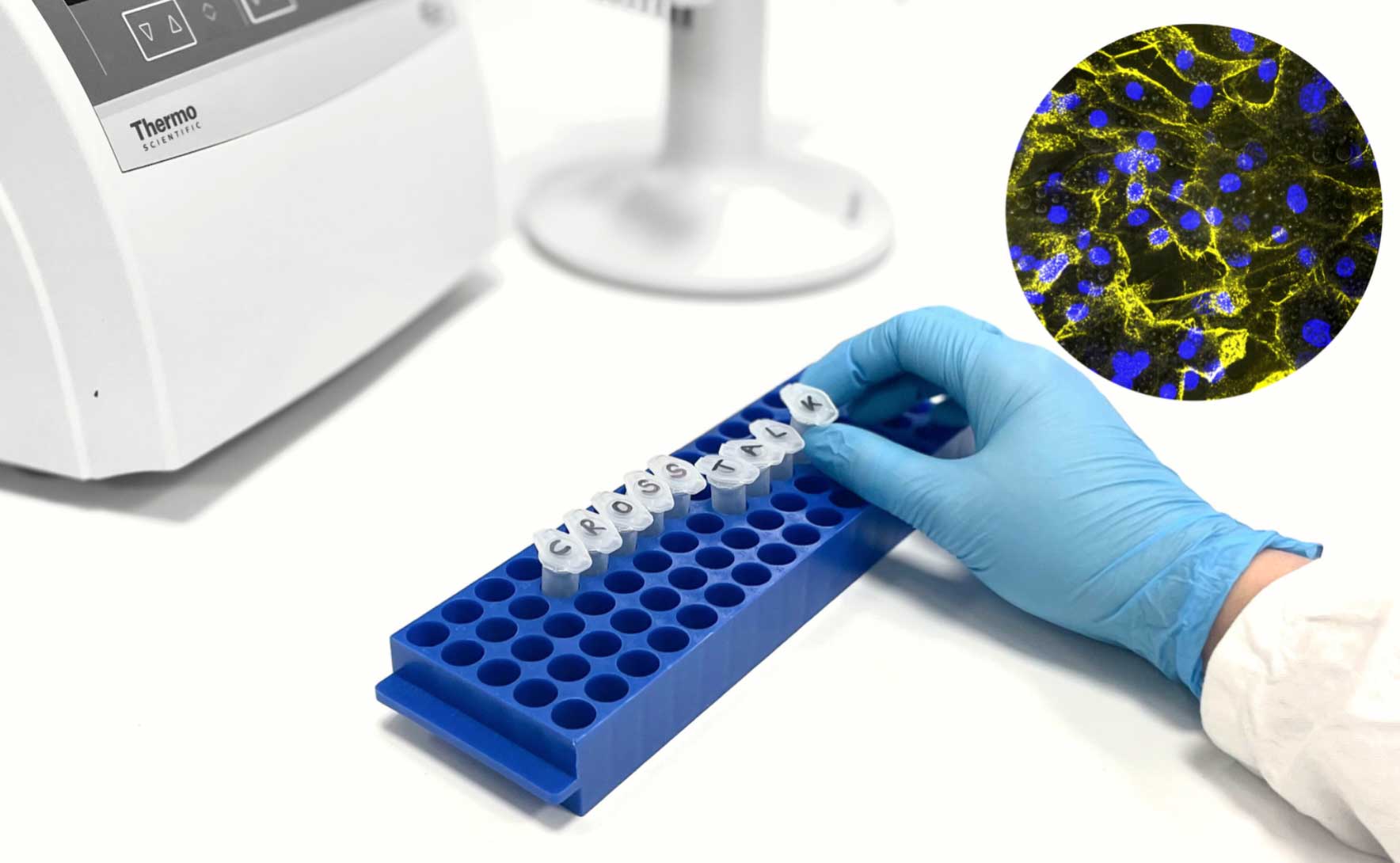
The research group Crosstalk explores how inter-tissue communication impacts energy balance and metabolic health.
Proteins are secreted from various cells of tissues and mediate inter-organ crosstalk. They can exert beneficial or detrimental effects, based on their concentration and context. The composition of secreted proteins, collectively known as the protein “secretome” changes with different stimuli, such as in exercise, diet changes, and different diseases. These changes in the composition of the secretome can have severe effects on the whole body.
Skeletal muscle and adipose tissue are key secretory organs. Exercise-induced myokines from skeletal muscle have beneficial effects and can reduce disease risks. Obesity-induced adipokines from adipose tissue often promote inflammation, which contributes to the development of obesity-related comorbidities. Thus, identification of previously unknown effector myokines and adipokines is crucial, not only to find specific biomarkers for diseases and therapeutic targets but also to understand the basic molecular mechanisms of how tissues communicate with each other. However, to date, many myokines and adipokines remain undiscovered. This is due to methodological limitations based on the low abundance of many of these proteins. Previously, we have developed a proteomics-based technique that allows for the identification of novel, low abundant myokines and adipokines in the extracellular fluid of muscle and adipose tissue. We are utilizing this technique to find unknown myokines and adipokines and subsequently study their molecular signaling cascades. By understanding how these proteins function and influence whole body metabolism, we aim at contributing to the development of new treatments for obesity, diabetes, and related comorbidities.
Specifically, we are focusing on the following aims:
- Adipokines and their role in high fat diet-induced adipose tissue inflammation (1).
- Exercise-induced myokines and their beneficial effects on obesity and diabetes (2).
- Molecular mechanisms of the novel myokine PSAP in adipose tissue maintenance (3).
Team
Selected Publications
- Sprenger H-G, Mittenbühler MJ, Sun Y, Van Vranken JG, Schindler S, Jayaraj A, Khetarpal SA, Smythers AL, Vargas-Castillo A, Puszynska AM, Spinelli JB, Armani A, Kunchok T, Ryback B, Seo H-S, Song K, Sebastian L, O'Young C, Braithwaite C, Dhe-Paganon S, Burger N, Mills EL, Gygi SP, Paulo JA, Arthanari H, Chouchani ET, Sabatini DM, Spiegelman BM 2025. Ergothioneine controls mitochondrial function and exercise performance via direct activation of MPST. Cell metabolism. 37: 857-869.e9. https://doi.org/doi.org/10.1016/j.cmet.2025.01.024
- Burger N, Mittenbühler MJ, Xiao H, Shin S, Wei SM, Henze EK, Schindler S, Mehravar S, Wood DM, Petrocelli JJ, Sun Y, Sprenger H-G, Latorre-Muro P, Smythers AL, Bozi LHM, Darabedian N, Zhu Y, Seo H-S, Dhe-Paganon S, Che J, Chouchani ET 2025. The human zinc-binding cysteine proteome. Cell. 188: 832-850.e27. https://doi.org/doi.org/10.1016/j.cell.2024.11.025
- Mittenbühler M, Smythers AL, Spiegelman BM 2024. Proteomic profiling of extracellular fluids to identify secreted proteins from muscle and fat tissues. Methods Cell Biology. https://doi.org/doi.org/10.1016/bs.mcb.2024.08.004
- Ducommun S, Jannig PR, Cervenka I, Murgia M, Mittenbühler MJ, Chernogubova E, Dias JM, Jude B, Correia JC, Van Vranken JG, Ocana-Santero G, Porsmyr-Palmertz M, McCann Haworth S, Martínez-Redondo V, Liu Z, Carlström M, Mann M, Lanner JT, Teixeira AI, Maegdefessel L, Spiegelman BM, Ruas JL 2024. Mustn1 is a smooth muscle cell-secreted microprotein that modulates skeletal muscle extracellular matrix composition. Molecular Metabolism. 82: 101912. https://doi.org/doi.org/10.1016/j.molmet.2024.101912
- A M, Wales TE, Zhou H, Draga-Coletă S-V, Gorgulla C, Blackmore KA, Mittenbühler MJ, Kim CR, Bogoslavski D, Zhang Q, Wang Z-F, Jedrychowski MP, Seo H-S, Song K, Xu AZ, Sebastian L, Gygi SP, Arthanari H, Dhe-Paganon S, Griffin PR, Engen JR, Spiegelman BM 2023. Irisin acts through its integrin receptor in a two-step process involving extracellular Hsp90α. Molecular cell. 83: 1903-1920.e12. https://doi.org/doi.org/10.1016/j.molcel.2023.05.008
- Mittenbühler MJ, Jedrychowski MP, Van Vranken JG, Sprenger H-G, Wilensky S, Dumesic PA, Sun Y, Tartaglia A, Bogoslavski D, A M, Xiao H, Blackmore KA, Reddy A, Gygi SP, Chouchani ET, Spiegelman BM 2023. Isolation of extracellular fluids reveals novel secreted bioactive proteins from muscle and fat tissues. Cell metabolism. 35: 535-549.e7. https://doi.org/doi.org/10.1016/j.cmet.2022.12.014
- Kam T-I, Park H, Chou S-C, Van Vranken JG, Mittenbühler MJ, Kim H, A M, Choi YR, Biswas D, Wang J, Shin Y, Loder A, Karuppagounder SS, Wrann CD, Dawson VL, Spiegelman BM, Dawson TM 2022. Amelioration of pathologic α-synuclein-induced Parkinson's disease by irisin. Proceedings of the National Academy of Sciences of the United States of America. 119: e2204835119. https://doi.org/doi.org/10.1073/pnas.2204835119
- Mittenbühler MJ, Saedler K, Nolte H, Kern L, Zhou J, Qian S-B, Meder L, Ullrich RT, Brüning JC, Wunderlich FT 2020. Hepatic FTO is dispensable for the regulation of metabolism but counteracts HCC development in vivo. Molecular Metabolism. 42: 101085. https://doi.org/doi.org/10.1016/j.molmet.2020.101085
- Kern L, Mittenbühler MJ, Vesting AJ, Ostermann AL, Wunderlich CM, Wunderlich FT 2018. Obesity-Induced TNFα and IL-6 Signaling: The Missing Link between Obesity and Inflammation—Driven Liver and Colorectal Cancers. Cancers. 11. https://doi.org/doi.org/10.3390/cancers11010024
- Mittenbühler MJ, Sprenger H-G, Gruber S, Wunderlich CM, Kern L, Brüning JC, Wunderlich FT 2018. Hepatic leptin receptor expression can partially compensate for IL-6Rα deficiency in DEN-induced hepatocellular carcinoma. Molecular Metabolism. 17: 122-133. https://doi.org/doi.org/10.1016/j.molmet.2018.08.010
